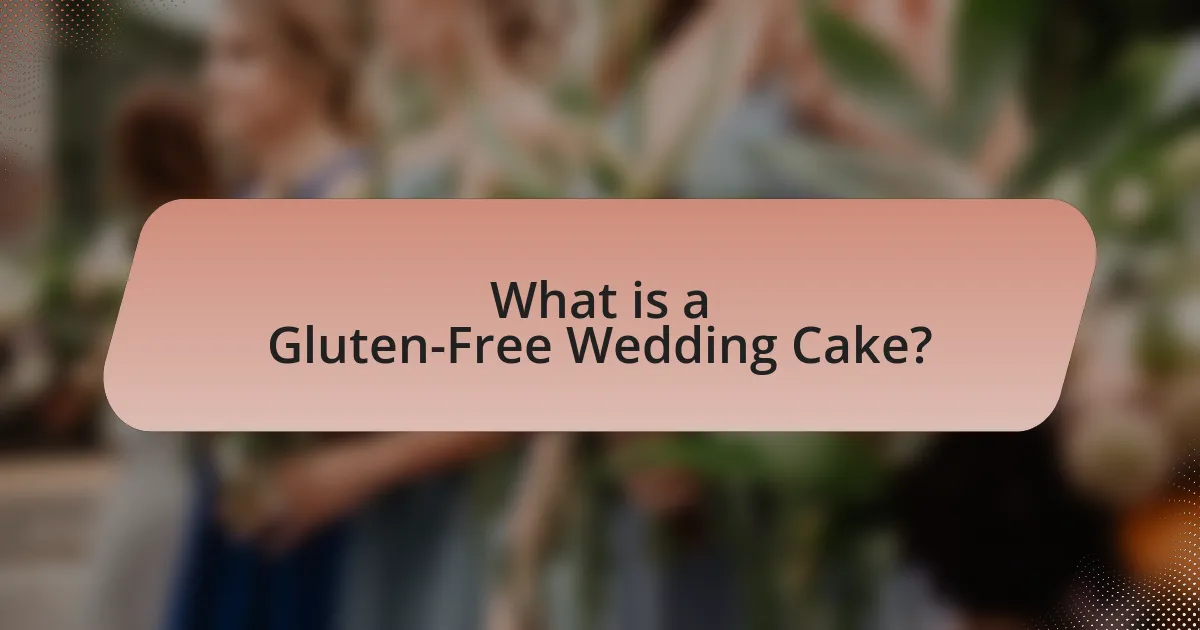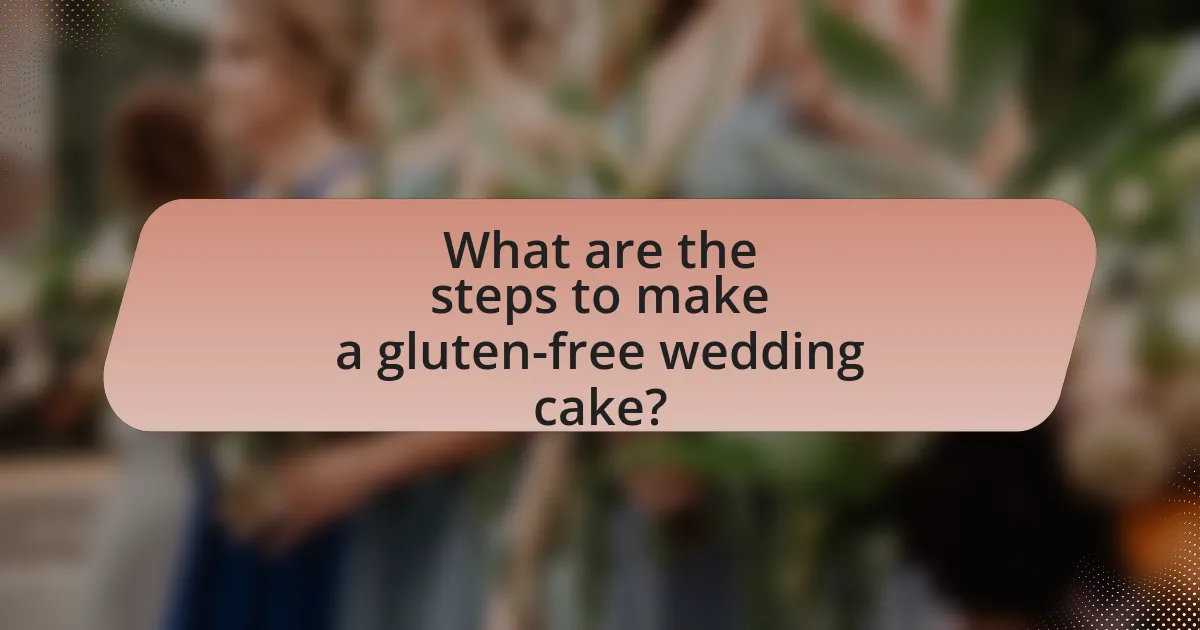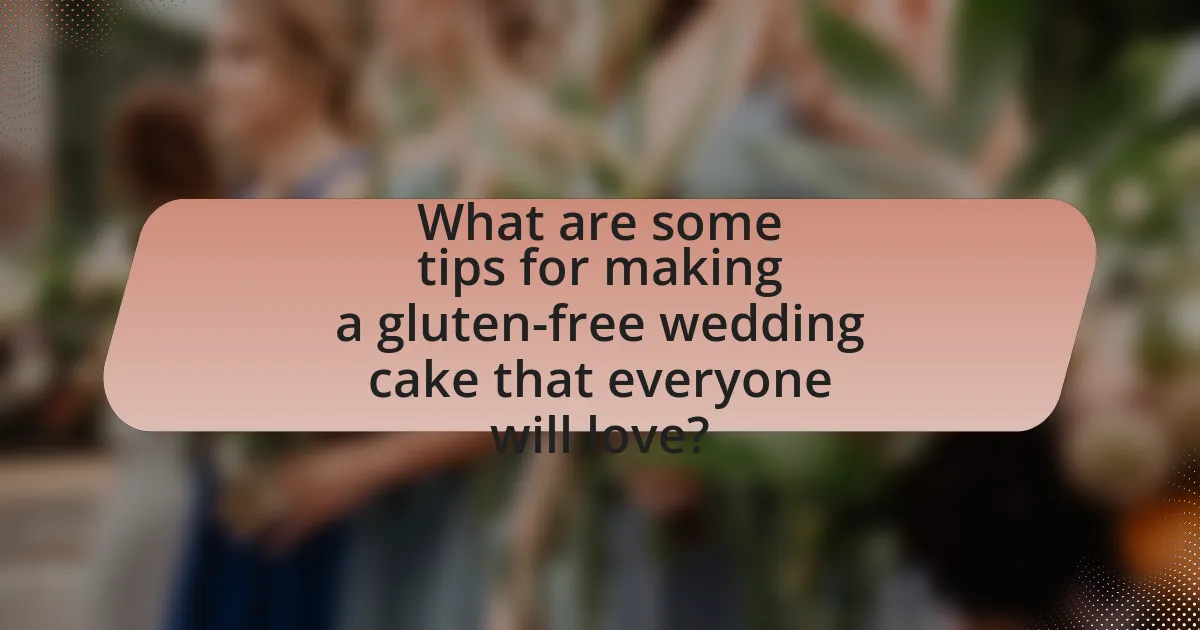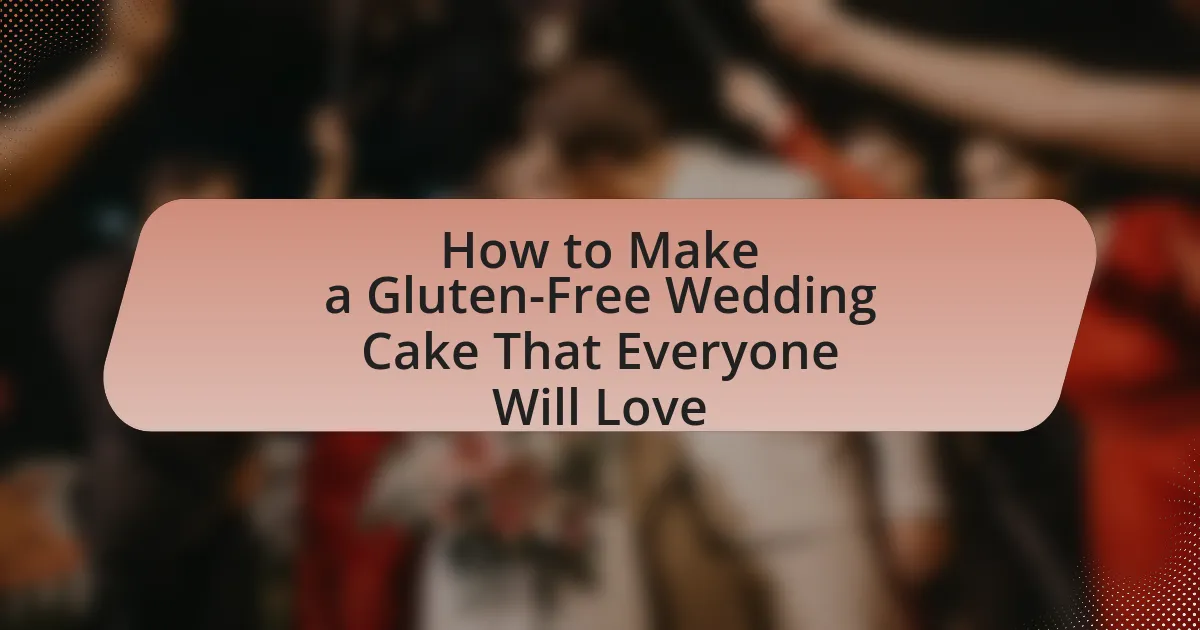A gluten-free wedding cake is specifically crafted without gluten-containing ingredients, making it suitable for individuals with gluten sensitivities or celiac disease. This article provides a comprehensive guide on creating a gluten-free wedding cake that appeals to all guests, detailing essential ingredients, popular flavor combinations, and the importance of using alternative flours like almond and coconut. It also addresses dietary needs, baking techniques, and decoration options, ensuring that the cake is both delicious and safe for those avoiding gluten. Additionally, the article offers troubleshooting tips and best practices for serving, emphasizing the significance of preventing cross-contamination and ensuring a satisfying experience for everyone at the celebration.

What is a Gluten-Free Wedding Cake?
A gluten-free wedding cake is a cake specifically made without gluten-containing ingredients, catering to individuals with gluten sensitivities or celiac disease. These cakes utilize alternative flours, such as almond, coconut, or rice flour, to achieve the desired texture and flavor while ensuring safety for those avoiding gluten. The demand for gluten-free options has increased, with studies indicating that approximately 1% of the population has celiac disease, necessitating gluten-free alternatives in various food categories, including wedding cakes.
Why choose a gluten-free wedding cake for your special day?
Choosing a gluten-free wedding cake for your special day ensures that all guests, including those with gluten sensitivities or celiac disease, can enjoy the celebration without health concerns. Gluten-free cakes can be made with alternative flours such as almond, coconut, or rice flour, which not only cater to dietary restrictions but can also offer unique flavors and textures. Research indicates that approximately 1% of the population has celiac disease, and many others may have gluten intolerance, making gluten-free options increasingly popular and necessary for inclusive dining experiences.
What are the dietary needs that gluten-free cakes address?
Gluten-free cakes address the dietary needs of individuals with celiac disease and gluten sensitivity, who cannot consume gluten without experiencing adverse health effects. Celiac disease affects approximately 1% of the population, leading to severe gastrointestinal and systemic symptoms when gluten is ingested. Gluten sensitivity, which can affect a larger segment of the population, also necessitates the avoidance of gluten to prevent discomfort and health issues. By using gluten-free ingredients, these cakes provide safe dessert options for those with these dietary restrictions, ensuring inclusivity at events like weddings.
How does a gluten-free cake differ from a traditional wedding cake?
A gluten-free cake differs from a traditional wedding cake primarily in its ingredients, specifically the absence of wheat flour. Traditional wedding cakes typically use wheat flour, which contains gluten, a protein that provides structure and elasticity. In contrast, gluten-free cakes utilize alternative flours such as almond, coconut, or rice flour, which do not contain gluten. This substitution affects the texture and density of the cake; gluten-free cakes may be denser and require additional binding agents like eggs or xanthan gum to achieve a similar consistency to traditional cakes.
What ingredients are essential for a gluten-free wedding cake?
Essential ingredients for a gluten-free wedding cake include gluten-free flour, eggs, sugar, butter or oil, baking powder, and milk or a dairy-free alternative. Gluten-free flour blends, often made from rice flour, almond flour, or tapioca starch, serve as the primary base, providing structure and texture. Eggs act as a binding agent, while sugar adds sweetness. Butter or oil contributes moisture and richness, and baking powder is necessary for leavening. Milk or a dairy-free alternative ensures the right consistency in the batter. These ingredients collectively create a cake that is both delicious and suitable for those with gluten sensitivities.
Which gluten-free flours work best for wedding cakes?
Almond flour and coconut flour are among the best gluten-free flours for wedding cakes. Almond flour provides a moist texture and rich flavor, while coconut flour absorbs moisture and adds a subtle sweetness. Both flours can be combined with other gluten-free options like tapioca flour or rice flour to achieve a balanced structure and taste. Research indicates that using a blend of these flours can enhance the cake’s texture and flavor profile, making it more appealing to a wider audience.
What role do binders play in gluten-free baking?
Binders play a crucial role in gluten-free baking by providing structure and moisture to baked goods. In the absence of gluten, which typically gives elasticity and stability, binders such as xanthan gum, guar gum, and psyllium husk help to mimic these properties, ensuring that the final product holds together and maintains a desirable texture. Research indicates that the use of these binders can significantly improve the quality of gluten-free products, making them more palatable and similar to their gluten-containing counterparts. For instance, a study published in the Journal of Food Science found that incorporating xanthan gum in gluten-free bread improved its volume and crumb structure, demonstrating the effectiveness of binders in enhancing gluten-free baking outcomes.
How can you ensure your gluten-free wedding cake is delicious?
To ensure your gluten-free wedding cake is delicious, use high-quality gluten-free flours such as almond flour, coconut flour, or a gluten-free all-purpose blend that contains xanthan gum for better texture. These flours provide moisture and flavor, which are essential for a tasty cake. Additionally, incorporating ingredients like eggs, yogurt, or applesauce can enhance the cake’s richness and moisture, making it more enjoyable. Research indicates that cakes made with a combination of gluten-free flours often yield better taste and texture compared to those made with a single type (source: “Gluten-Free Baking: A Comprehensive Guide” by Rebecca Reilly).
What flavor combinations are popular for gluten-free cakes?
Popular flavor combinations for gluten-free cakes include chocolate and raspberry, lemon and blueberry, and vanilla and almond. These combinations are favored due to their complementary tastes and the ability to enhance the overall flavor profile of the cake. For instance, chocolate and raspberry create a rich and tart contrast, while lemon and blueberry offer a refreshing and zesty balance. Vanilla and almond provide a classic and aromatic foundation that appeals to many palates. These combinations are widely used in gluten-free baking to ensure that the cakes are both delicious and satisfying.
How can you enhance the texture of a gluten-free cake?
To enhance the texture of a gluten-free cake, incorporate a combination of gluten-free flours, such as almond flour and coconut flour, along with a binding agent like xanthan gum. This blend improves moisture retention and creates a more cake-like structure. Research indicates that using a mix of flours can provide a better crumb and texture, as different flours contribute unique properties; for example, almond flour adds richness while coconut flour absorbs moisture. Additionally, incorporating eggs can help bind the ingredients and add airiness, further improving the cake’s overall texture.

What are the steps to make a gluten-free wedding cake?
To make a gluten-free wedding cake, follow these steps: First, gather gluten-free flour, sugar, eggs, butter, baking powder, and any desired flavorings or fillings. Next, preheat the oven to the appropriate temperature, usually around 350°F (175°C). Then, mix the dry ingredients, including gluten-free flour and baking powder, in one bowl and the wet ingredients, such as eggs and melted butter, in another. Combine the wet and dry mixtures until smooth. Pour the batter into greased cake pans and bake for the recommended time, typically 25-30 minutes, or until a toothpick inserted comes out clean. Allow the cakes to cool completely before frosting with gluten-free icing. This method ensures a delicious gluten-free wedding cake that meets dietary needs.
How do you prepare the ingredients for a gluten-free cake?
To prepare the ingredients for a gluten-free cake, first, gather gluten-free flour, which can be a blend of rice flour, almond flour, and tapioca flour. Measure the required amounts accurately, as gluten-free baking often requires precise ratios. Next, ensure that all other ingredients, such as baking powder, sugar, eggs, and any flavorings, are also gluten-free; check labels for certification. For optimal results, sift the gluten-free flour and baking powder together to aerate the mixture, which helps achieve a lighter texture in the cake. This method is supported by the fact that gluten-free flours behave differently than wheat flour, necessitating adjustments in preparation techniques.
What is the importance of measuring ingredients accurately?
Measuring ingredients accurately is crucial for achieving the desired texture and flavor in a gluten-free wedding cake. Gluten-free baking relies on precise ratios of ingredients to compensate for the absence of gluten, which provides structure and elasticity in traditional cakes. For instance, using too much or too little of a key ingredient, such as flour or sugar, can result in a cake that is either too dense or too crumbly. Studies have shown that accurate measurements can improve the consistency of baked goods, leading to a more enjoyable eating experience. Therefore, precise measurement is essential for successful gluten-free baking.
How can you prevent cross-contamination in gluten-free baking?
To prevent cross-contamination in gluten-free baking, use dedicated utensils, equipment, and surfaces that have not been in contact with gluten-containing ingredients. This practice is essential because even trace amounts of gluten can trigger reactions in individuals with celiac disease or gluten sensitivity. For instance, research indicates that gluten can remain on surfaces and tools, leading to unintentional exposure. Additionally, thoroughly clean all baking areas and equipment before use, and store gluten-free ingredients separately from gluten-containing products to further minimize the risk of cross-contamination.
What is the baking process for a gluten-free wedding cake?
The baking process for a gluten-free wedding cake involves several key steps. First, gather gluten-free flour blends, which typically include a mix of rice flour, almond flour, and tapioca starch to achieve the desired texture. Next, preheat the oven to the appropriate temperature, usually around 350°F (175°C).
Then, combine the dry ingredients, including the gluten-free flour, baking powder, and salt, in one bowl, while mixing the wet ingredients, such as eggs, sugar, and vanilla extract, in another. Gradually incorporate the dry mixture into the wet mixture, ensuring a smooth batter.
Pour the batter into greased cake pans and bake for approximately 25-30 minutes, or until a toothpick inserted in the center comes out clean. Allow the cakes to cool completely before frosting. This method is supported by numerous gluten-free baking resources, which emphasize the importance of using a proper flour blend and following specific baking times for optimal results.
How long should you bake a gluten-free cake?
Bake a gluten-free cake for 25 to 35 minutes at 350°F (175°C). This baking time is generally effective for most gluten-free cake recipes, ensuring that the cake is fully cooked while maintaining moisture. The use of a toothpick to check for doneness is recommended; it should come out clean when inserted into the center of the cake.
What signs indicate that a gluten-free cake is done baking?
A gluten-free cake is done baking when it has risen, the edges pull away from the pan, and a toothpick inserted into the center comes out clean or with a few moist crumbs. These signs indicate that the cake has set properly and is fully cooked. The rising of the cake occurs due to the leavening agents reacting with the batter, while the edges pulling away suggest that the structure has stabilized. The toothpick test is a widely accepted method for determining doneness in cakes, confirming that the internal temperature has reached a safe level for consumption.
How do you decorate a gluten-free wedding cake?
To decorate a gluten-free wedding cake, use gluten-free fondant, fresh fruits, edible flowers, or gluten-free chocolate ganache. These options ensure that the decoration complements the cake while adhering to gluten-free requirements. For instance, gluten-free fondant can be rolled out and shaped into elegant designs, while fresh fruits and edible flowers add natural beauty and color. Additionally, gluten-free chocolate ganache can be poured over the cake for a rich finish. These methods not only enhance the visual appeal but also maintain the integrity of a gluten-free diet.
What frosting options are suitable for gluten-free cakes?
Suitable frosting options for gluten-free cakes include buttercream, cream cheese frosting, and ganache. These frostings are typically made from gluten-free ingredients such as butter, sugar, cream cheese, and chocolate, ensuring they do not contain gluten. For instance, traditional buttercream is made with powdered sugar and butter, both of which are gluten-free. Additionally, cream cheese frosting, which combines cream cheese and powdered sugar, is also safe for gluten-free diets. Ganache, made from chocolate and heavy cream, is another excellent choice as it is inherently gluten-free. These options provide delicious and safe choices for gluten-free wedding cakes.
How can you create beautiful decorations without gluten?
You can create beautiful decorations without gluten by using naturally gluten-free materials such as fondant made from rice flour, cornstarch, or almond flour. These alternatives allow for intricate designs and vibrant colors while ensuring that the decorations remain gluten-free. Additionally, edible flowers, fruits, and gluten-free sprinkles can enhance the visual appeal of the cake without compromising dietary restrictions.

What are some tips for making a gluten-free wedding cake that everyone will love?
To make a gluten-free wedding cake that everyone will love, use a combination of gluten-free flours such as almond flour, coconut flour, or a gluten-free all-purpose blend to achieve the right texture and flavor. Incorporating ingredients like eggs and yogurt can enhance moisture and richness, which are crucial for a delicious cake. Additionally, ensure to use high-quality flavorings, such as pure vanilla extract or citrus zest, to elevate the taste.
For proof, studies show that gluten-free cakes can be just as enjoyable as traditional cakes when the right ingredients and techniques are employed. A survey by the Gluten Intolerance Group found that 81% of gluten-free consumers reported satisfaction with gluten-free baked goods when made with quality ingredients.
How can you test your gluten-free cake for taste and texture?
To test your gluten-free cake for taste and texture, conduct a sensory evaluation by tasting and assessing the cake’s crumb structure, moisture level, and flavor profile. The crumb structure should be light and airy, indicating proper leavening, while the moisture level should be balanced, neither too dry nor overly wet. Flavor should be rich and well-rounded, without any off-putting aftertastes. Research shows that gluten-free cakes often require specific combinations of flours and binders to achieve desirable taste and texture, such as using almond flour or coconut flour alongside xanthan gum for improved structure.
What feedback should you seek from taste testers?
Seek feedback from taste testers on flavor, texture, sweetness, and overall satisfaction. Specifically, inquire about the balance of flavors to ensure the cake is enjoyable, the texture to confirm it is moist and not crumbly, the level of sweetness to avoid overwhelming the palate, and their overall impression to gauge if it meets expectations for a wedding cake. This feedback is crucial as it helps refine the recipe to ensure it appeals to a wide audience, particularly for a significant event like a wedding.
What common mistakes should you avoid when making a gluten-free wedding cake?
When making a gluten-free wedding cake, avoid using only one type of gluten-free flour, as this can lead to a dense texture. Instead, combine different gluten-free flours, such as almond flour and coconut flour, to achieve a balanced structure and flavor. Additionally, do not skip the use of binders like xanthan gum or psyllium husk, which are essential for mimicking the elasticity of gluten. Failing to properly measure ingredients can also result in an imbalanced cake; always use a kitchen scale for accuracy. Lastly, avoid underbaking the cake, as gluten-free cakes often require longer baking times to set properly.
How can you troubleshoot common gluten-free baking issues?
To troubleshoot common gluten-free baking issues, first identify the specific problem, such as texture, rising, or flavor. For texture issues, ensure the right blend of gluten-free flours, as using a combination of flours like almond, coconut, and tapioca can improve consistency. If the cake does not rise, incorporate a leavening agent like baking powder or baking soda, and ensure the ingredients are fresh, as expired leavening agents can hinder rising. For flavor concerns, adding ingredients like vanilla extract or citrus zest can enhance taste. These strategies are supported by the fact that gluten-free baking often requires adjustments in ingredient ratios and types to mimic the properties of gluten.
What are the best practices for serving a gluten-free wedding cake?
The best practices for serving a gluten-free wedding cake include ensuring that all utensils and serving equipment are free from gluten contamination, clearly labeling the cake to inform guests of its gluten-free status, and using separate serving areas to avoid cross-contact with gluten-containing foods. These practices are essential because gluten can trigger severe reactions in individuals with celiac disease or gluten sensitivity. According to the Celiac Disease Foundation, even trace amounts of gluten can cause health issues for those affected, making strict adherence to gluten-free protocols crucial during events like weddings.
How can you ensure your guests enjoy the gluten-free cake?
To ensure your guests enjoy the gluten-free cake, use high-quality gluten-free flour blends that mimic the texture and taste of traditional cake. Research indicates that blends containing a mix of almond flour, coconut flour, and tapioca flour provide a moist and flavorful result, appealing to both gluten-free and non-gluten-free guests. Additionally, incorporating rich flavors, such as chocolate or vanilla, and adding ingredients like fruits or nuts can enhance the overall taste, making the cake enjoyable for everyone.
